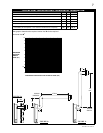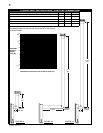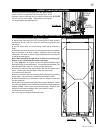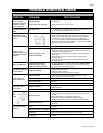
21
W415-0619 / B / 03.03.08
TROUBLE SHOOTING GUIDE
BEFORE ATTEMPTING TO TROUBLESHOOT, PURGE YOUR UNIT AND INITIALLY LIGHT THE IGNITOR AND THE MAIN BURNER WITH THE GLASS DOOR OPEN.
SYMPTOM PROBLEM TEST SOLUTION
Electrode sparks, burner
ignites, electrode
continues to spark for
complete 7 seconds,
burner shuts down.
Hot and neutral wires are reversed
at control module.
Sensor / fl ame not connecting
- Connect the hot wire to the black wire. Connect the neutral wire to
the white wire.
- Raise electrode / sensor up into fl ame.
Main burner fl ame is a
blue, lazy, transparent
fl ame.
Blockage in vent.
- Remove blockage. In extremely cold conditions, ice buildup may occur
on the terminal and should be removed as required.
Flame length
consistently too large
or too small. Carboning
occurs.
Unit is over-fi red or under-fi red. - Check pressure readings
- Outlet pressure can be checked by removing cap (A) and replacing
it with a 1/8” NPT barb fi tting. Next, place pressure gauge tubing
over the fi tting. Gauge should read 3.5” W.C. for natural gas or
10.0” W.C. for propane. AFTER TAKING PRESSURE READINGS,
BE SURE TO REPLACE CAP TO RESEAL. DO NOT OVER-TORQUE.
- Leak test with a soap and water solution.
Carbon is being
deposited on glass, logs
or combustion chamber
surfaces.
Air shutter has become blocked. - Ensure air shutter opening is free of lint or other obstructions.
Flame is impinging on the
combustion chamber.
- Open air shutter to increase the primary air.
- Check the input rate: check the manifold pressure and orifi ce size as
specifi ed by the rating plate values.
- Check that the door gasketing is not broken or missing and that the
seal is tight.
- Check that both 3” and 5” vent liners are free of holes and well
sealed at all joints.
- Check that the minimum rise per foot has been adhered to for any
horizontal venting.
White / grey fi lm forms.
Sulphur from fuel is being
deposited on glass, logs or
combustion chamber surfaces.
- Clean the glass with a gas fi replace glass cleaner. DO NOT CLEAN
GLASS WHEN HOT. If deposits are not cleaned off regularly, the
glass may become permanently marked.
Exhaust fumes smelled in
room, headaches.
Fireplace is spilling.
- Check door seal.
- Check pressure relief device.
- Check for chimney blockage.
- Ensure that the paint curing process is complete.
No gas to the main
burner; switch is on.
Switch is defective.
- Connect a jumper wire across the wall switch terminals; if main
burner lights, replace switch / thermostat.
Burner orifi ce is blocked. - Remove stoppage in orifi ce.
Control valve faulty. - Replace.
Faulty valve. - Replace.
Burner will not light,
ignitor sparks.
No gas at the burner.
- Check that the manual valve is turned on.
- Replace the valve.
Out of propane gas. - Fill the tank.
Ignitor
will
not
spark.
No spark at ignitor.
- Check the power source. (ie. fuse, circuit breaker)
- Check that the wire is connected to both the ignitor and the control
module.
- Check that the spark is not jumping to ignitor cover.
- Replace the wire if the wire insulation is broken or frayed.
- Replace the electrode if the ceramic insulator is cracked or broken.
Spark gap is incorrect.
- Spark gap should be 0.125” (1/8” approx.) from the electrode tip to the
sensor tip.
Remote wall switch is in
“OFF” position; burner
comes on.
Wall switch is mounted upside
down.
- Reverse.
Remote wall switch is grounding. - Replace.
Remote wall switch wire is
grounding.
- Check for ground (short); repair ground or replace wire.
Faulty wire. - Replace.


















